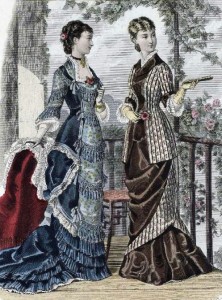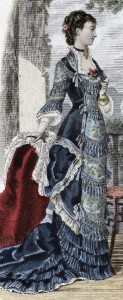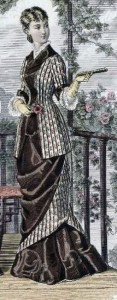Friday’s Fashion Plate
Natural Form Day Dress & Dinner Dress
This is a fashion plate from the middle of the Natural Form era. It contains a dinner dress and a day dress.
The Natural Form period existed from about 1877 until 1882, a time when the bustle temporarily vanished. Of this particular fashion plate, 1878 or 1879 is my guess because the brown dress retains a hint of a train, which had disappeared for daytime use by 1880, and because the skirt draping is on the cusp between the graceful swags of the late 1870s and the almost geometric styles of the early 1880s.
Left
My favorite is the one on the left, a dinner dress of slate blue silk cut in the princess style. The skirt is slender, with a train that would have enhanced the illusion of sleekness. A narrow wire crinoline might have been worn to keep the skirts from tangling between the legs, but only one or two slender petticoats would have been worn.
It has a classic Queen Anne neckline, where the back is high and the front cuts away to a square or diamond-shaped décolletage edged with lace. A rose is fastened at the center of her neckline. The sleeves are three-quarter length, with a slightly belled cuff and a white crystal-pleated ruffle. The front of the dress is inset with a floral printed silk, which is swagged with long blue fringe and edged with small bows. The side drapery is in the waterfall style, where it’s folded in a way that produces a flip-flop effect, and it’s trimmed with lace. The bottom of the skirt and the train are edged with three tiers of crystal-pleated ruffles. A white balayeuse peeks out beneath the train.
She wears light colored gloves, perhaps pale gray, that come partway up her forearms, and a thick gold bracelet on one wrist. Her only other jewelry is a black ribbon choker with a gold pendant. She wears her hair pulled back on the sides, in a large updo, with a slight amount of fringe at her forehead, and a pink flower for ornamentation.
Right
The dress on the right would be for daytime wear, perhaps a visiting dress. It appears to be made of cream silk with a floral stripe pattern and accents of solid brown. The skirt is cut very narrow, and the tunic-length bodice fastens like a jacket, with a wide collar and high neckline. There is a bit of white lace at the neck. The bodice is two-toned, with a solid inset in the center. The sleeves are three-quarter length, with a brown cuff and two layers of crystal-pleated white ruffle. The nearly hidden skirt is solid brown and has a slight train, while the overskirt is asymmetrical, with a very long brown apron and a diagonal drape of the striped fabric.
She wears buff-colored gloves that button midway up her forearms. She carries a rose and a fan, and wears no jewelry. Her hair is parted in the center, waved as it’s pulled back on the sides, and worn in a low chignon.
~~*~~
Which is your favorite of the two dresses shown? What do you like about it?




2 Responses to Natural Form Fashion Plate